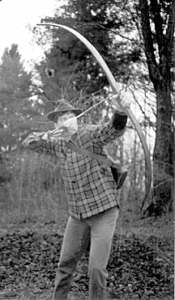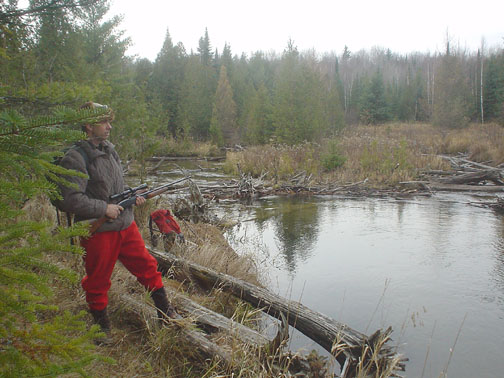I think the ranking of social nobility starts with the values and activities of work, next is recreation (creative recovery and rest), and last comes sport. And sport itself is only valuable in homage to the worker.
In this line-up we have the bike commuter coming in ahead of the recreational cyclist. They’re both fine activities but the one seems essentially more noble to me. Maybe because it’s in fact more essential. It’s integrated to the more primary needs in life. However, if the work itself is honest then the creative recovery from it is noble, too.
In this vein, hunting and fishing are worthy ways to get meat and a challenge at the same time. But someone who does it for work, for livelihood, for cash, to create something of a commodity item, seems nobler to me. A small local-type of operator would, however, provide the “commodity” on a local basis, in season, at sustainable volumes.
Fur-trappers are the farmers of the forest, field and stream. And small-scale commercial fishermen are the farmers of the waters.
Fur and leather items last for decades and are renewable. They give greater repeated value than a mere meal. And trapping and net-fishing give great economies of scale. They use the mind. They don’t act on a one-to-one, hand-to-hand level. One fisherman, one fish isn’t a very good way to actually feed anyone, even one person. From the start of civilization, humanity worked to get economy of scale in feeding/gathering. One always needs to use conservation, of course. But getting what you need from nature is so risky in the long term that one needs to give yourself the best odds. And that’s nets and traps.
The good thing is that both most nets and traps are actually quite well targeted, safe and humane. They’re not hardly a risk to anything but the desired critters and they hold them reasonably or dispatch them promptly.
***
As an aside, I personally prefer trapping to hunting due to the added elements of craft. It’s more about craft than stealth, in a way. There’s robust hiking, working more with wood and stakes, but mostly I enjoy using all the scents. Animals communicate via smell mostly. Trappers enter into this fully, with food, territorial and mating scents. They also often have to control their own scents and trap scents by way of boiling, dyeing and waxing. The scents use the whole range, too: from sweet to rotten to glandular. Preparing your own lures, baits and scents is also fascinating work. I’m sure it starts out repulsive but one comes to have an appreciation for the whole range. I’m to the point where the smell of a skunk has a positive meaning to me…sometimes.
But enough of comparative nobility evaluation and miscellany. It’s likely that people today don’t understand enough about any of these suggestions to appreciate them. : ) Nor will they investigate reasonably before making a decision. So I suppose some background info is in order.
As regards the assumed cruelty of trapping, one should be part of that world before judging it, and not as a bystander. Not as someone there to be shocked. The media only covers trapping to sell papers. People with truly cruel agendas enjoy using the media to shock the innocent and to exert power over any person they can.
Trapping is about life and death. This is something totally foreign to nearly everyone today. Yet it’s the definition of nature: the cycle of life and death, for the sake of life. Still, one can see how truly natural living will be foreign and by extension uncomfortable to most people from the get-go. This is a barrier that I’ve personally helped some people across by bringing them along on traplines with me. Not as people to exploit me and deliver paid shock value to an audience but as people willing to learn. (And what can we say about the ability to learn? It’s not at all as common as we might think. Nor is it likely done in our usual ways.)
By design, trapping either promptly kills an animal or holds it by the foot for a few hours. Nearly all trappers check their lines daily, in the morning. Animals are caught a few hours earlier. Traps aren’t designed to break the skin much less break bones. 95% of animals caught are intended, but a busy trapper might have to release a couple unintended animals during a season. These animals don’t even typically lose a toe. A leg-trapped animal panics for a few minutes, then rests. I don’t think it’s right to judge animal suffering on our scale. Of course most people die in pain and the same applies to animals. They are nearly all prey and have short lives as a rule. Something gets them in short order, often their parents or relatives. And it’s never quick or painless. An “attack” by a trap is about the gentlest death or restraint that nature offers. And man is part of nature. Every other death involves, of course, being chased then torn apart or lingering disease. There is no exception. Exposure is sometimes a relevant factor in trapping. In other cases it can be helpful to remember that animals live outdoors.
Now, I hope it’s obvious that one shouldn’t judge trapping, hunting or the like on the basis of whether or not they could do it. Life isn’t interchangeable. One has to be from a more natural background to understand the outdoor life and deal with it. Or one has to desire to connect better to such roots. You need to have a right relationship with the field and stream before you presume to oversee it or judge those who do. For myself, when I’m far from nature, caught up in a paper reality, I don’t attempt to do these natural things. It wouldn’t be respectful. One doesn’t dabble; it’s serious. Few things are serious today. Moreover, it’s common to resent seriousness. What we call serious are usually matters of powerplays all done for ulterior motives. As in seriously treacherous, not nobly serious.
Trapping is of course harsh in a sense. It’s killing; it’s holding against a will. But it’s not capricious or unpredictable. It’s controlled and thus only relatively cruel. Any encounter with a human is stressful, or cruel, for an animal. They’re shocked and flee if they can. I don’t know what they THINK of us but their INSTINCT is alarm. Any death, disease or injury for an animal that has no relation to humans—in the wild—is far more alarming to them. It lasts far longer, and is definitely capricious and unpredictable. The trapper is definitely entering into the life cycle of animals. His role is either killing an animal outright or restraining it for a few hours. Compare what happens in the wild, but don’t turn away.
Thinking further out about our responsibility to reduce suffering everywhere, one can start to see that a root-source activity like trapping causes less pain and creates more direct benefit than a multi-impact extractive industry that makes the petrochemicals used in (short-lived) synthetic clothes or even agriculture. Trapping is closer to freedom for both sides of the equation. For instance, Native American modes of animal killing or human justice were often horrifying to Westerners but it could be said that in the long run they were humane. One might heinously tortures captives, criminals or even outsiders when one can’t afford war or even social deviation (due to food scarcity, for instance)—the price of freedom can be high. Yet I’ve read that going on the warpath was voluntary, so one could consider the risks. Most of us have totally given up our freedom. This affects our ability to judge those who haven’t. Freedom of course isn’t the same as liberty: it relates to justice and is a balance of all values, neglecting none, in a way that lets you best be yourself. Taking first-level responsiblity for our relations to animals seems like a possible path to freedom.
The reality of man is that he does well when he takes responsibility for the inevitable suffering of animals under him and does the best he can. Man has learned much about nature, obviously. Not to avoid it or pretend he’s in isolation from it, but to conserve and manage it. To relate to it rightly in each situation. The trapper and his prey are in a freedom relation where the trapper is responsible for front-line conservation decisions (such is needed to keep populations of all species in a healthy and thriving condition). A game commission can make rules based on science and inputs but the trappers can tell you what works.
When farmers are involved with domestic animals, they give them sufficient space and bedding for their species, with each species having its own particulars. (Good fur farmers do this, too.) Small farmers seem able to do this best because the large corporate approach seems to fall victim greed and abuse even more often. The trapper is the equivalent of the small organic farmer. In fact, most trappers use their same mentality during their whole year, not just during winter fur season. They harvest mushrooms in the spring. They plant gardens in summer. They raise bees. They run trotlines for fish. They don’t do it for fun so much as for a living—with fun being a side-effect, or “satisfaction,” more likely. Trappers tend to be wholesome, integrated generalists. Just like the Indians of old. Proud yet humble. Their livelihood tends to support their other values: they truly believe in “live free or die.” They tend to be poor—they know what money can buy. They live off their honey instead. They don’t live all cut into pieces like city folk so often do. It’s not work here, meddling in others affairs there, fun elsewhere. It’s all of a piece…and they’re on top, managing it all, owning up to it. But when the weather starts to get cold there’s nothing that can keep them out of the field…it’s time to start scouting, getting the lay of the land…
***
I hear that muskrats are up to $10 a pelt these days. This is the highest pricing, well, ever. In a way, it’s getting close to the heyday of trapping when I was a teenager in the mid-70’s and muskrats were $5 each. Movie tickets were $1.50. I’ve read that it’s because China is entering its first big era of prosperity and awareness of the inherent value of its natural resources. Fur is valued as conservation and stewardship values kick in. Also as personal initiative becomes valued. The last boom in fur occured as the USSR started to lose its slavery grip over its people in the early 80’s. Fur is a world value. Someday it might come back to the USA. But think of how a teenager today could be making a couple hundred bucks a week, cash, with no adult telling him what to do, no boss, just himself and initiative, to hike the swamps and work them marsh hares. Drainage ditches are everywhere. Or maybe they should be pulling levers at the fast-food ripoff joint instead. Forget that! Take the freedom road! : )
***



